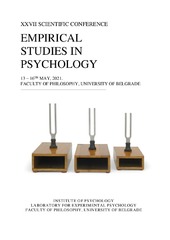Приказ основних података о документу
Learning dynamics during COVID-19 pandemic: high-school students in Serbia
| dc.creator | Jošić, Smiljana | |
| dc.creator | Đerić, Ivana | |
| dc.creator | Ševa, Nada | |
| dc.date.accessioned | 2021-06-10T12:23:34Z | |
| dc.date.available | 2021-06-10T12:23:34Z | |
| dc.date.issued | 2021 | |
| dc.identifier.isbn | 978-86-6427-166-0 | |
| dc.identifier.uri | http://ipir.ipisr.org.rs/handle/123456789/486 | |
| dc.description.abstract | Paper describes the dynamics of the distance learning process caused by COVID-19 pandemic from a student’s perspective. We explored some of the features of the learning process during long-distance learning: time learning, learning activities and school grades. Data were collected at three measurement points during the suspension of regular classes (March – end June 2020). A total sample of high school students who voluntarily participated in the survey was 159. The participants were 15-19 years old from all grades of gymnasia and vocational secondary schools. The average grade point assigned by the teachers in the 1st semester (end of 2019 year) was 4.64 (SD= .42) out of maximum 5. Three questionnaires (included open and closed questions) were distributed electronically at the end of the first week of long-distance learning, the second at the end of the fourth week and the third in the week when the classes ended. For the purpose of this study, we analysed questions referring to the number of learning hours, type of activities related to learning (for school or for out-ofschool activities) and final average grade. The results show that students changed the number of hours they devoted to learning from week to week. In the first week they spent around 8h in total for learning, lower than in the fourth week when they learned 15h in total (t(137) = −5.59, p<.05). In the final week students reported that they spend approximately the similar time learning as in the first week. We identified a large number of student extracurricular or recreational activities (sports, art, technology). There is a significant difference between the cumulative grade average at the end of the first semester and at the end of the school year 2020 (t(146) = -2,86, p<.05). This finding does not differ from the empirical findings obtained on a sample of students before the pandemic period. Students had statistically higher average grades at the end of the school year (M = 4.75; SD = 0.52) compared to the winter semester (M = 4.64; SD = 0.42). The student assessment of the impact of the COVID-19 pandemic on the final average grade shows that a larger number of students (68%) believe that this crisis did not have a great impact. In other words, students thought they would have the same average grade, if the classes took place regularly. Results of the study provided partial insights in the learning process of high-school students during the first three months of Covid pandemic. The findings showed that learning could be continued even in extreme circumstances like lockdown, and that students gradually were capable of adapting to the changes, by adjusting dynamics of their learning to the dynamic of school demands. | sr |
| dc.language.iso | en | sr |
| dc.publisher | Beograd : Laboratorija za eksperimentalnu psihologiju | sr |
| dc.publisher | Beograd : Filozofski fakultet | sr |
| dc.rights | openAccess | sr |
| dc.rights.uri | https://creativecommons.org/licenses/by/4.0/ | |
| dc.source | Empirical studies in psychology | sr |
| dc.subject | long distance learning | sr |
| dc.subject | COVID-19 | sr |
| dc.subject | learning time | sr |
| dc.subject | school grade | sr |
| dc.subject | longitudinal study | sr |
| dc.title | Learning dynamics during COVID-19 pandemic: high-school students in Serbia | sr |
| dc.type | conferenceObject | sr |
| dc.rights.license | BY | sr |
| dc.citation.epage | 66 | |
| dc.citation.spage | 66 | |
| dc.description.other | Knjiga rezimea / XXVII naučni skup Empirijska istraživanja u psihologiji | sr |
| dc.identifier.fulltext | http://ipir.ipisr.org.rs/bitstream/id/1348/bitstream_1348.pdf | |
| dc.identifier.rcub | https://hdl.handle.net/21.15107/rcub_ipir_486 | |
| dc.type.version | publishedVersion | sr |

